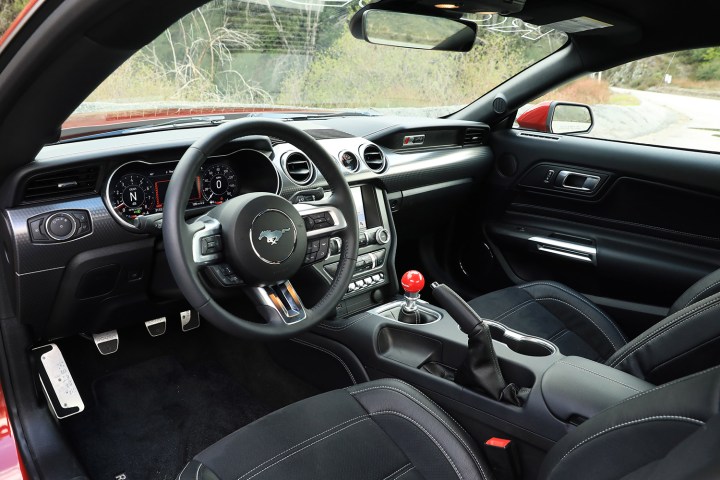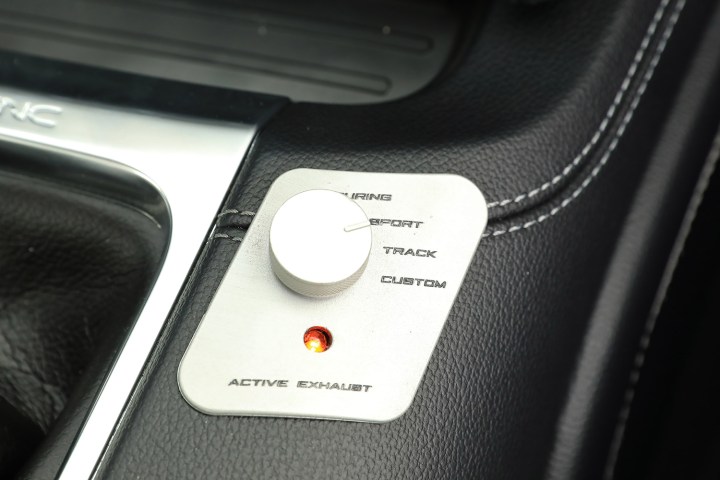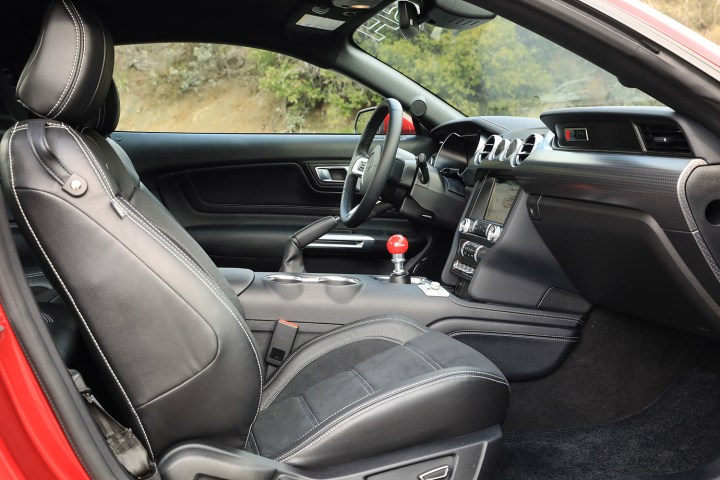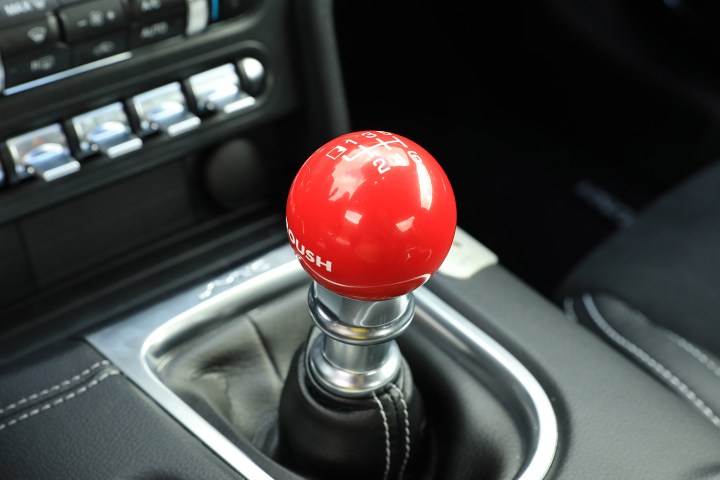“Supercharged power and a tuned chassis make for a seriously potent muscle car.”
- Gobs of midrange power
- Raucous muscle car soundtrack
- Comes with a warranty
- Coilover suspension lacks the versatility of factory-adaptive options
- Nonfunctional body kit components seem out of place on an $80K performance vehicle
In the era of ZL1s, Hellcats, and ZR1s, Ford is undeniably late to the high-performance party. After its initial debut in 2015, the sixth-generation Mustang has added a number of performance iterations to the roster, like the track-focused Shelby GT350 and GT350R, as well as the more budget-friendly Performance Pack 2 options package for the standard GT and the Bullitt special edition. While every one of those hopped-up ponies is a solid performer in its own right, none have the sheer grunt required to go toe-to-toe with the most potent hardware coming out of Dodge and Chevrolet factories.
After years of teasing the Ford faithful, the company finally took the wraps off its response at the North American International Auto Show earlier this year. But while the GT500 looks promising, it still has yet to land in Ford’s showroom. And when it does, it will lack an option that all of the GT500’s direct competitors offer: A manual gearbox.
Another option
For those who are tired of playing the waiting game, or want to row their own gears, or simply want something a little different that won’t be subject to exorbitant dealer markups, Roush Performance offers another option. Founded in 1995 by automotive industry luminary Jack Roush, the tuning company has specialized in hot-rodding Ford’s factory offerings for the past quarter century, amassing a collection of more than 1,500 performance parts for models like the Mustang, Focus, and F-Series pickups.
When it comes to Mustangs, the latest Stage 3 package sits at the top of Roush’s performance totem pole. Boasting 710 horsepower and 610 pound-feet of torque as well as your choice of a six-speed manual gearbox or a 10-speed automatic, the supercharged pony offers the necessary straight-line performance to run with the big dogs. Roush also provides all the right chassis tweaks to keep the package balanced, as well as a distinctive look to help set it apart from the crowd.
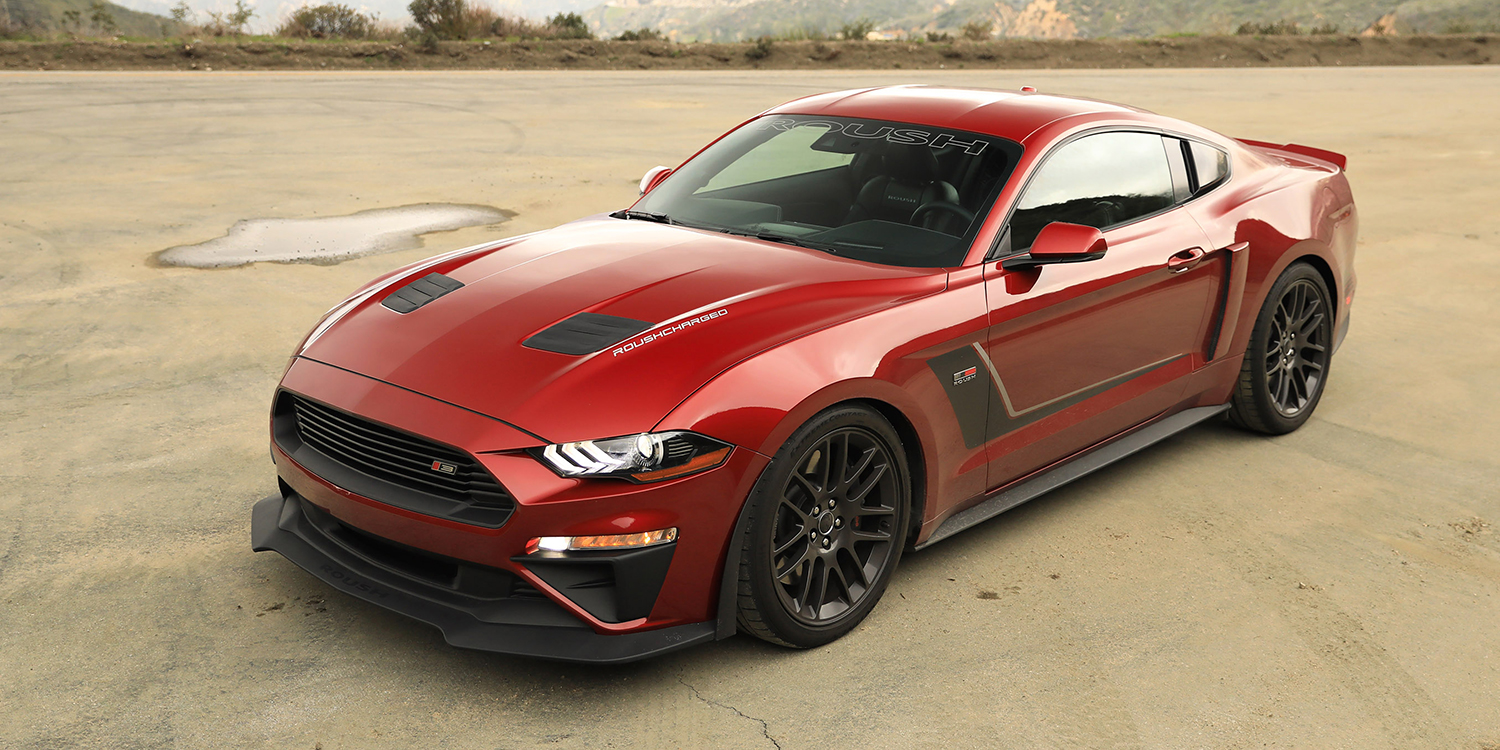
This particular machine was originally a 2019 Mustang GT Premium that was outfitted with the Performance Pack 1 options package, which includes a Torsen-branded differential, big Brembo brakes, an uprated steering rack, and some other go-fast goodies that brought its sticker price to $48,335. Roush’s Stage 3 package kit adds an additional $22,925 on top of the original purchase price of the car. Add in a handful of optional extras above and beyond the Stage 3 package, and the car’s total cost comes in at $78,123.
That’s a lot of coin for a Mustang, but there’s the promise of a lot of capability in return. To find out if Roush’s Stage 3 Mustang can scratch enthusiasts’ itch for hair-raising performance, we grabbed the keys to this Ruby Red example and headed for the hills.
Design
The Roush Stage 3 Mustang may have started life as a garden-variety GT, but the tuner has put significant effort into elevating its aesthetic alongside the performance upgrades. All the factory Ford badging is gone, replaced by Roush signage on the fenders, hood, tail light panel, and elsewhere. Visual aggression is amplified not only by the Stage 3’s hunkered-down stance, but also by way of a graphics package, unique upper and lower grilles, massive 20-inch wheels (cast wheels are standard, the optional forged wheel is equipped here), and a very racy body kit.
Details like the side scoops and optional quarter window scoops are purely ornamental. While they do add a bit of a flair to the overall look, these nonfunctional parts hark back to a time when tuner body kits wrote checks they hoped no one would ever try to cash, and their inclusion seems a bit out of place on a 700 horsepower car with a near-$80K purchase price.
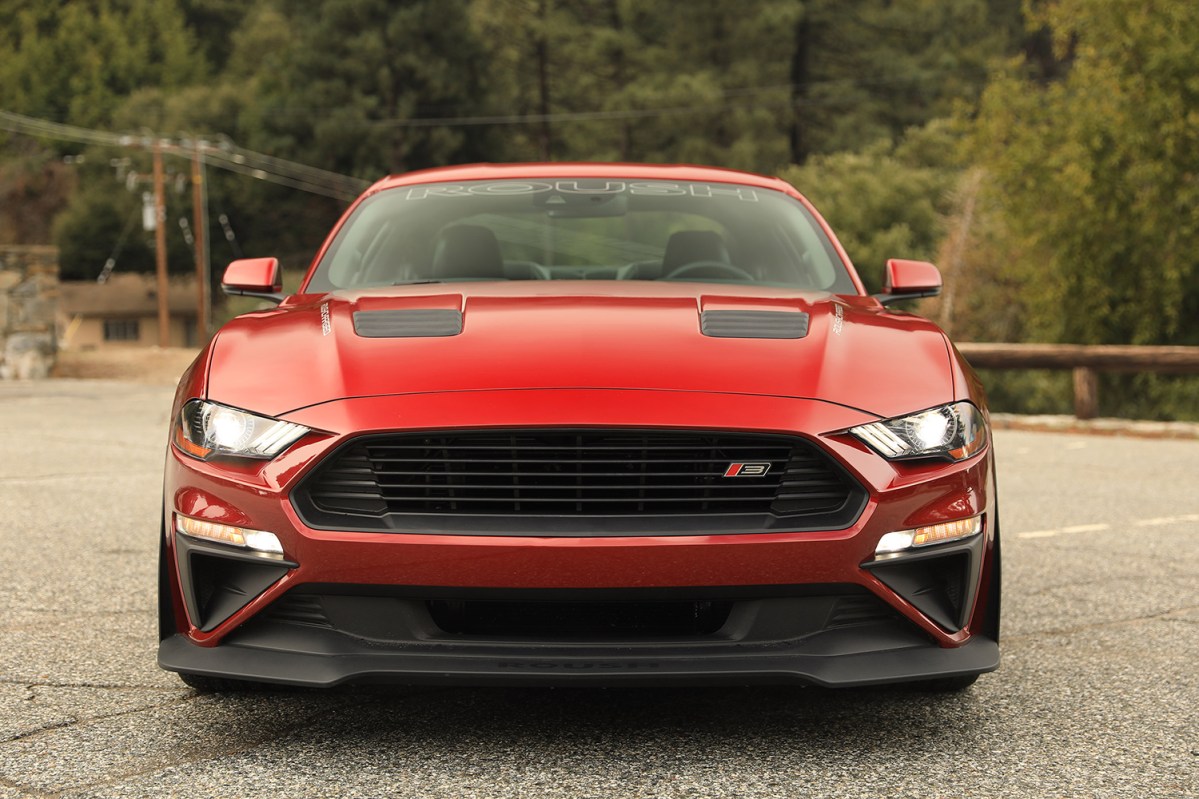
Aesthetic theater or not, this Mustang will certainly turn heads. Roush’s kit blends well with the recently refreshed GT’s factory look, adding enough style to make the Stage 3 look special without going over the top.
Inside, the changes are less dramatic. A serialized dash plaque and a pair of boost gauges are the only changes included as standard in the Stage 3 package, but our tester also features the optional Roush leather seats, billet pedals, and the red shift knob from Roush’s menu of available upgrades to give the cabin a little more pizzazz. As a result, the Stage 3’s interior will feel familiar to anyone who’s been in a sixth-generation Mustang, but keen-eyed observers will be able to detect from a glance that Roush has had a hand in enhancing this pony’s performance.
Tech features
As with all 2019 Mustang GTs, the Stage 3 benefits from the tech that Ford has brought to the table in recent years. Along with the available all-digital gauge cluster and SYNC 3 infotainment, system, the latter of which includes an 8-inch touchscreen with support for Android Auto and Apple CarPlay, 2019 brings automatic rev-matching into the mix.
First seen on the Bullitt Mustang, the feature provides downshifts that perfectly sync the rotational speed of the engine with the gearbox in manual transmission-equipped Mustangs, in turn enhancing stability during performance driving while making whoever is behind the wheel look and sound like a hero. Heel-and- toe fanatics can easily disable the feature in the menu system if they prefer to do so.
Our test model also included Roush’s optional active performance exhaust system. The quad-tipped setup not only looks like it means business, it’s also programmable via an iOS app, a unique feature that provides the owner of the vehicle with the ability to “tune” their exhaust note to their preference. The package also includes a center console-mounted control knob that allows the driver to switch the exhaust’s setting on the fly without thumbing through the system menus.
Driving impressions
Although the Stage 3 package is a collection of upgrades, the centerpiece is undoubtedly the 2.65-liter TVS blower that Roush installs on top of the 5.0-liter Coyote V8. In stock guise, that Double OverHead Cam (DOHC) mill churns out a healthy 460 hp and 420-lb.-ft.of torque, but add the 12 psi of boost from the 50-state-legal TVS blower and those numbers soar to 710 hp and 610 lb.-ft.
Around town, the additional power isn’t as noticeable as you might expect, and with the factory gearbox and clutch still on board, the Roush Stage 3 remains as easy to drive as a standard GT. But get out to a clear piece of tarmac where the car can stretch its legs, and the blower definitely makes its presence known. The Coyote remains a rev-happy engine, too, and the benefits of the supercharger climb alongside the engine RPMs.
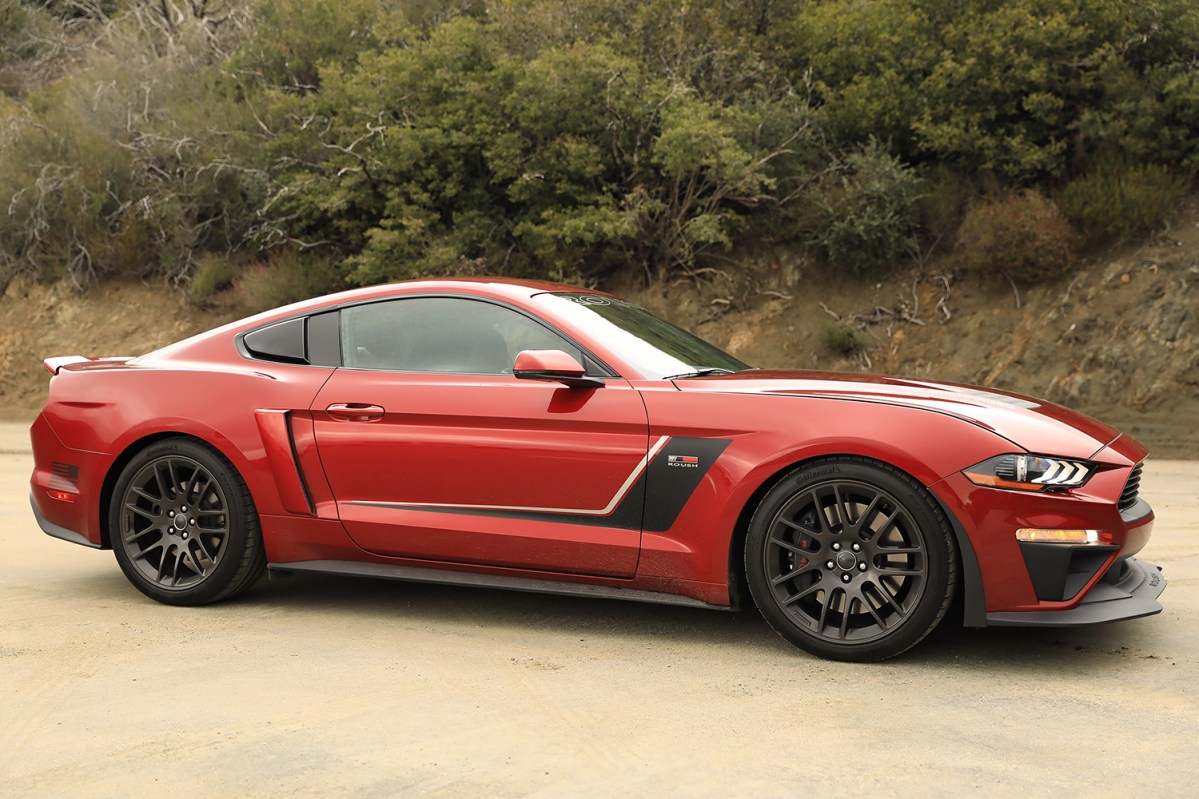
One place where the improvements are less obvious is in the chassis tweaks. This particular GT was optioned with the standard static suspension setup, but an adaptive MagneRide damping system is optional from the factory on all GTs. The rationale here is that since Roush outfits the Stage 3 Mustang with its own coilover suspension setup – a one-way adjustable setup that can be upgraded to a three-way adjustable coilover, as Roush as done here – the factory stuff is getting tossed anyway. That also allows Roush to both tune the response of the suspension as well as the ride height.
The problem is that the MagneRide system provides the ability for the suspension’s stiffness to be adjusted on the fly while Roush’s coilover system does not. The upshot is that the suspension can feel too stiff in certain situations and not stiff enough in others, and making adjustments to the coilovers’ characteristics requires some hand tools and a trip to the garage.
While it’s certainly fast and capable, the cushy Roush seats, factory stock brakes, and lack of additional cooling for drivetrain components make it clear that the Stage 3 is designed to be more of a muscled grand tourer than a track monster. It holds its own in that regard though, propelling the Mustang with serious urgency and a roaring soundtrack that’s contagiously entertaining.
Rivals
The Roush Stage 3 Mustang’s biggest rivals come directly from the showroom floors of Dodge and Chevrolet. The former’s Challenger SRT Hellcat starts at $58,995 for a bare-bones example with 717 horsepower, while a Widebody package will set you back an additional $6,000.
Even though the cars make similar peak horsepower, the Challenger’s 6.2-liter Hemi provides a noticeable advantage in low-end torque, and it feels faster in a straight-line sprint as a result. But the Mustang’s smaller, lighter, and more sportscar-like platform make it the better handler of the two when the road gets curvy.
The $62,000 Chevrolet Camaro ZL1 takes the opposite approach. Although it’s down 60 horsepower to the Roush, its world-class chassis will allow the Chevy to handily outrun the Mustang on a twisty piece of tarmac. However, it comes at the cost of poor outward visibility, a chintzy looking interior, and a general lack of personality.
Peace of mind
Roush includes heavy-duty half shafts as part of the Stage 3 package to improve drivetrain durability, but we did have some lingering concerns about the stock clutch and gearbox. To help ease those fears, the Roush includes a powertrain warranty that covers the axle shafts and other components for five years or 60,000 miles.
How DT would configure this car
It’s worth noting that Roush offers all the components that are part of the Stage 3 package a la carte through its parts catalog, so folks who want supercharged power but would rather skip the other upgrades can do so if they choose.
We’d probably go that route and pair up the TVS blower and the heavy-duty half shafts with the brake and suspension improvements that come as part of the Performance Pack 2 options package. Combining a track-tuned factory options package and MagneRide suspension with Roush’s supercharger should, in theory, yield the best of both worlds for a lot less money.
Our Take
We’ll have to wait to make a definitive call on whether the Roush Stage 3 Mustang a is viable alternative to the upcoming GT500 until we get some seat time in the latest Shelby. However, if exclusivity paired with hair-raising performance is your thing, the 2019 Roush Stage 3 Mustang certainly delivers on both fronts.
Should you get one?
Although it may not be the most fiscally sound way to a fast, modern muscle machine, cars like the Roush Stage 3 Mustang appeal to enthusiasts on an emotional level rather than a pragmatic one. It’s not the final word in Mustang performance, but the Roush delivers on the promises made by its aesthetic, and for many would-be buyers, that’s probably all they need to know. If that describes you, your supercharged pony car awaits.

